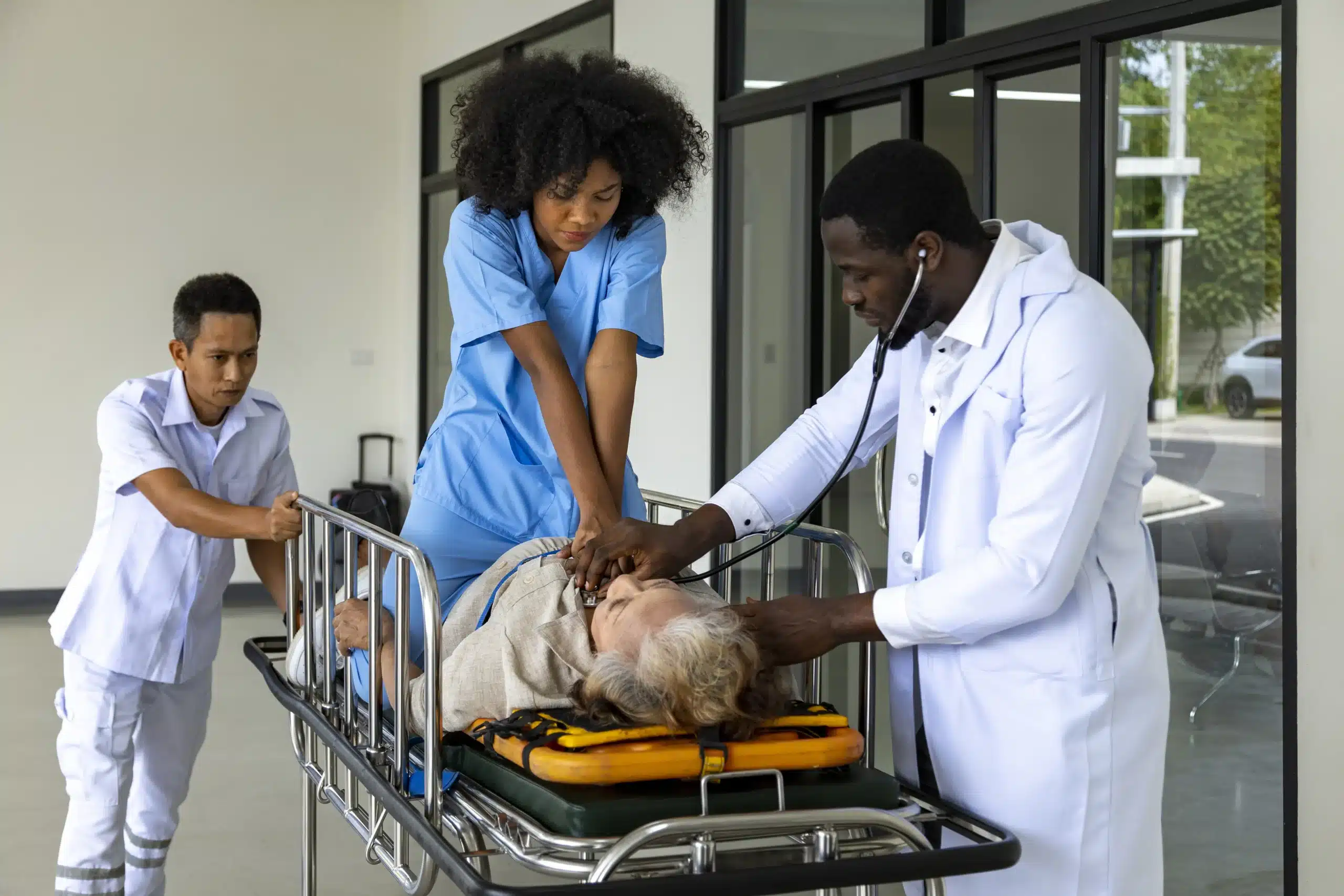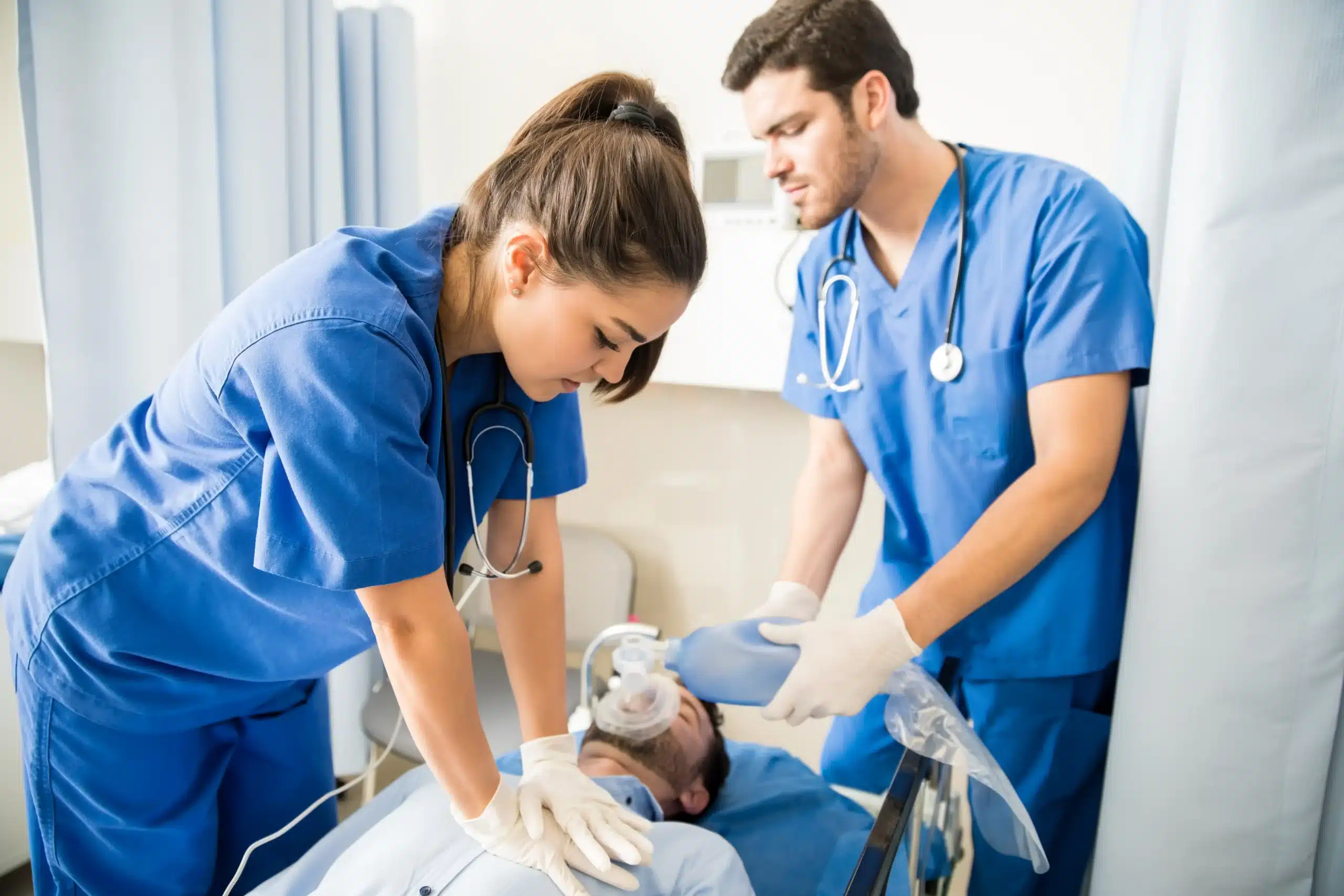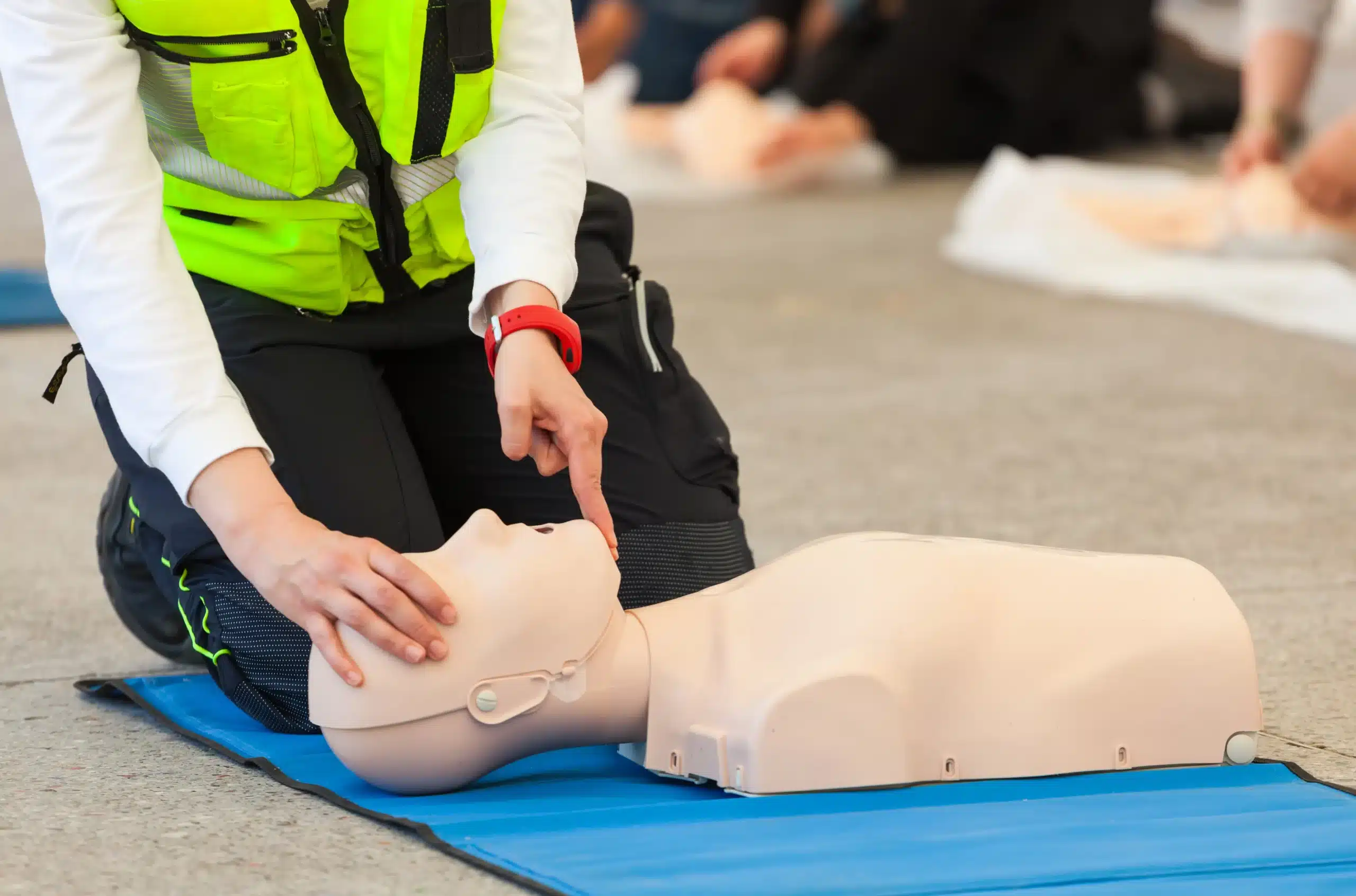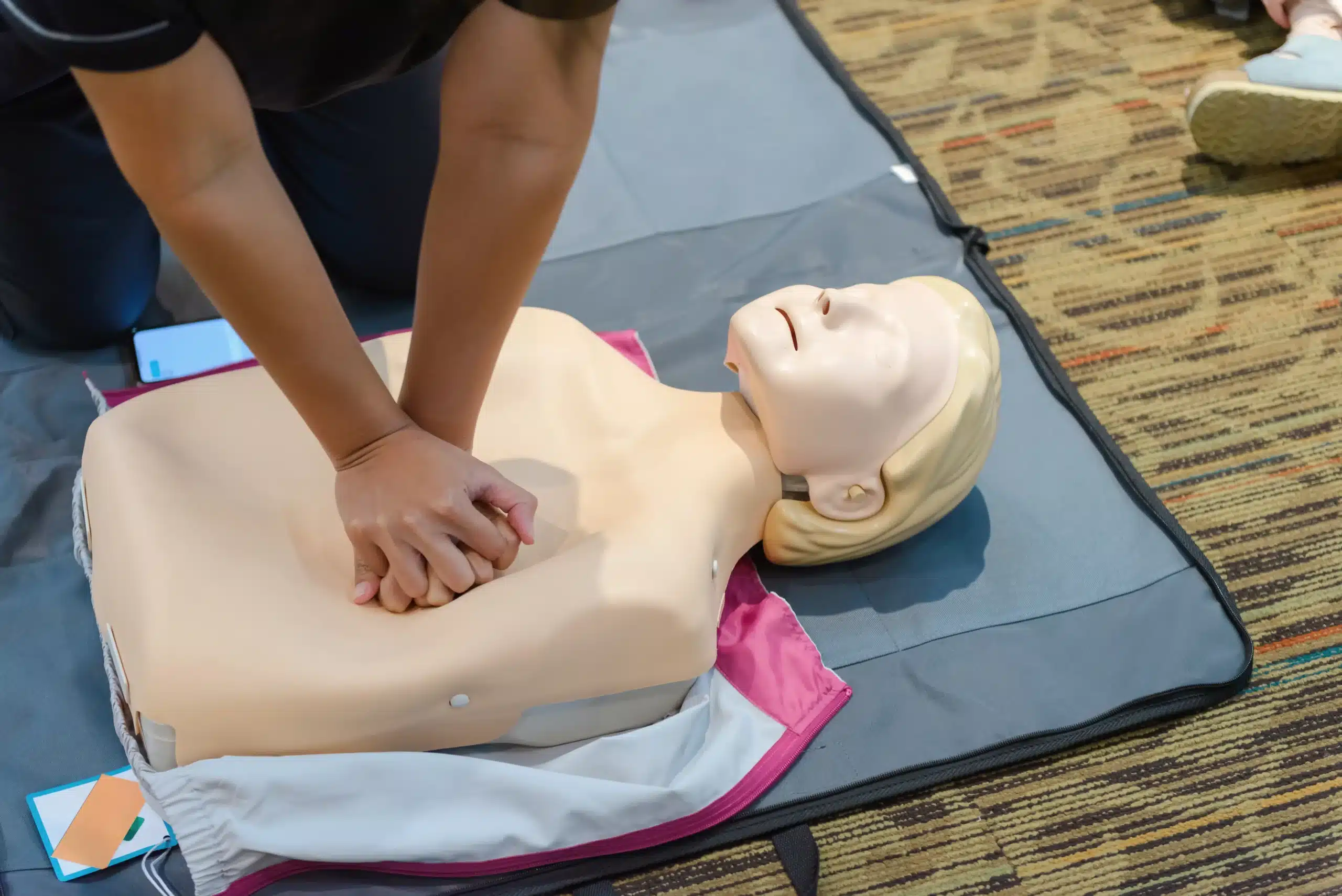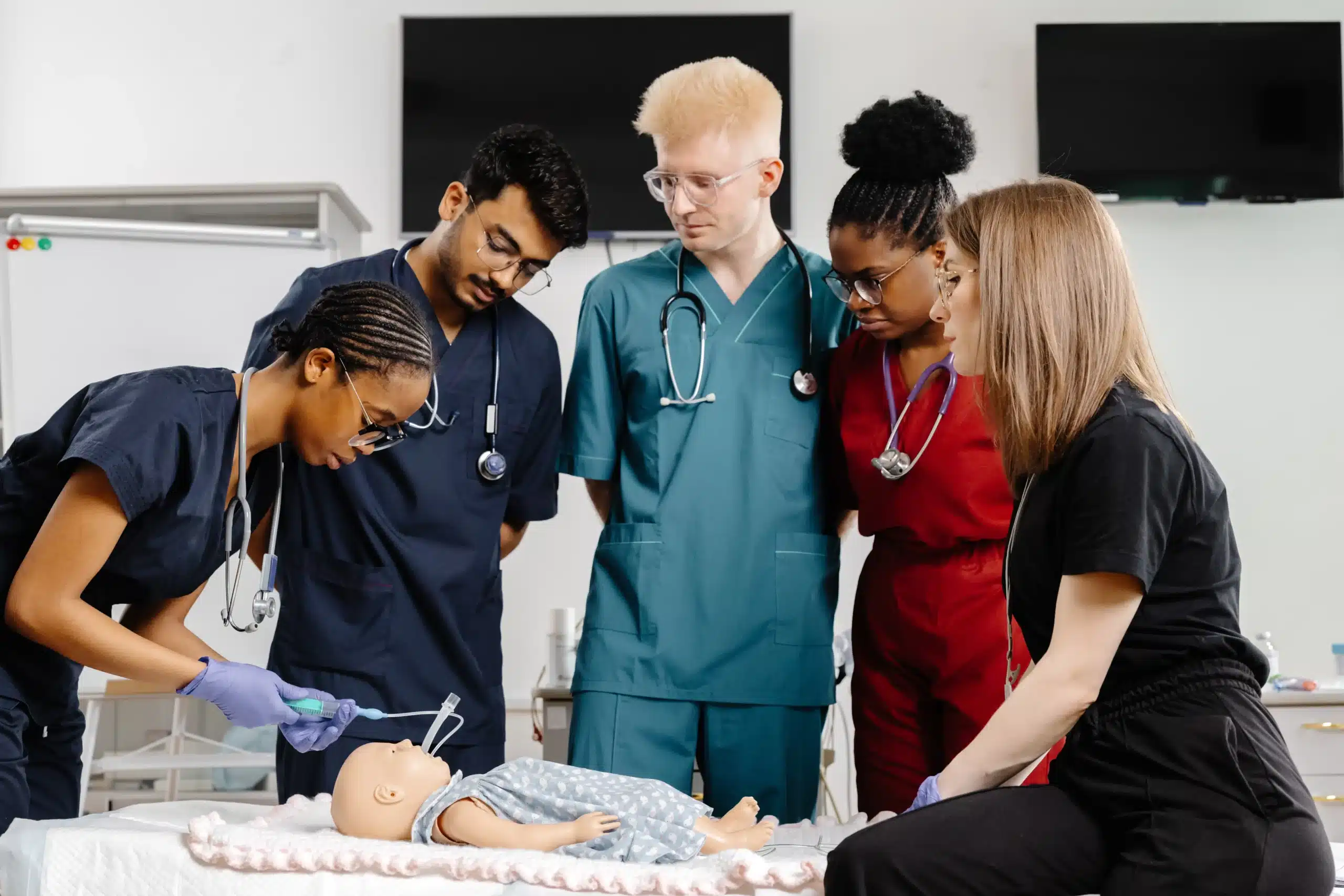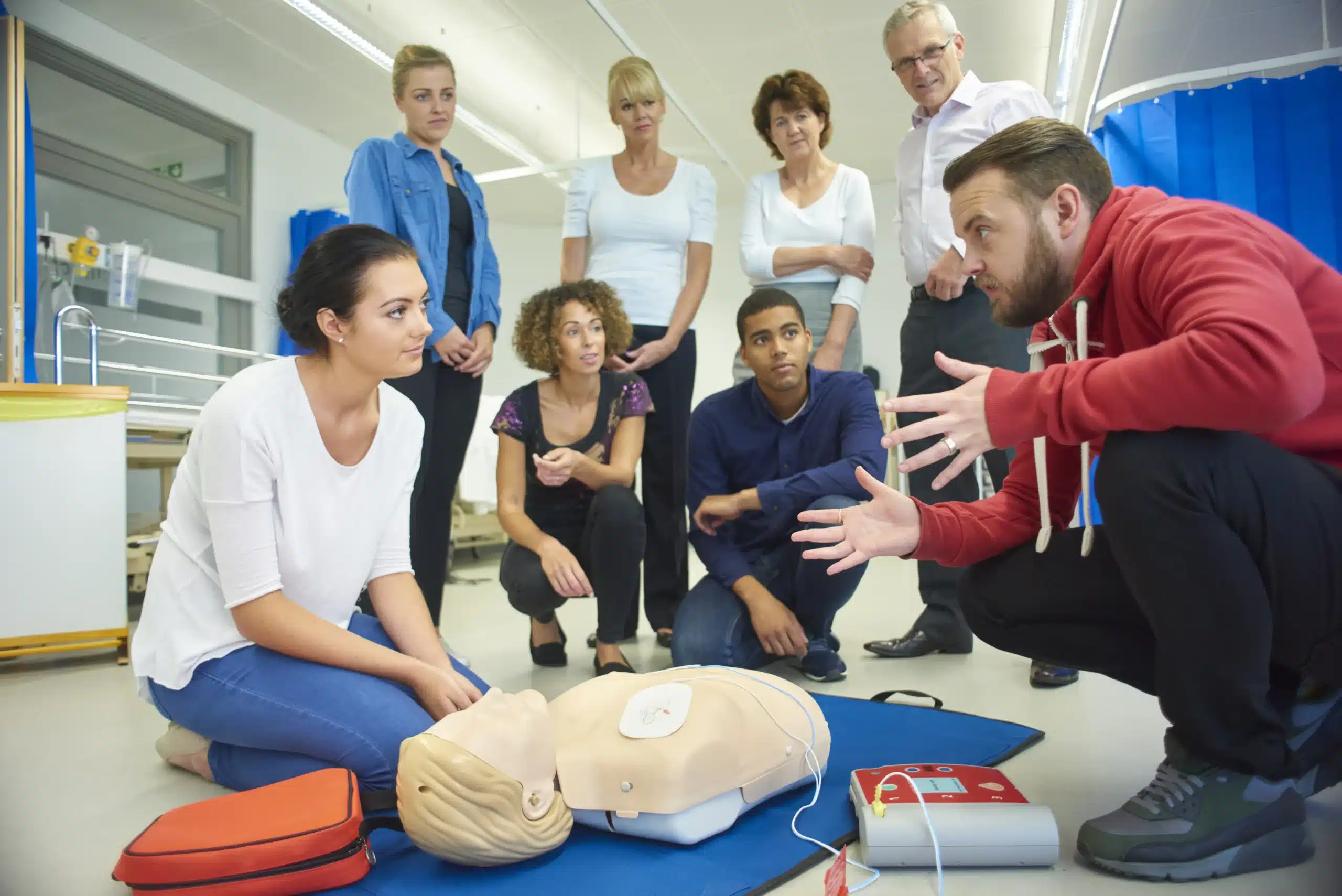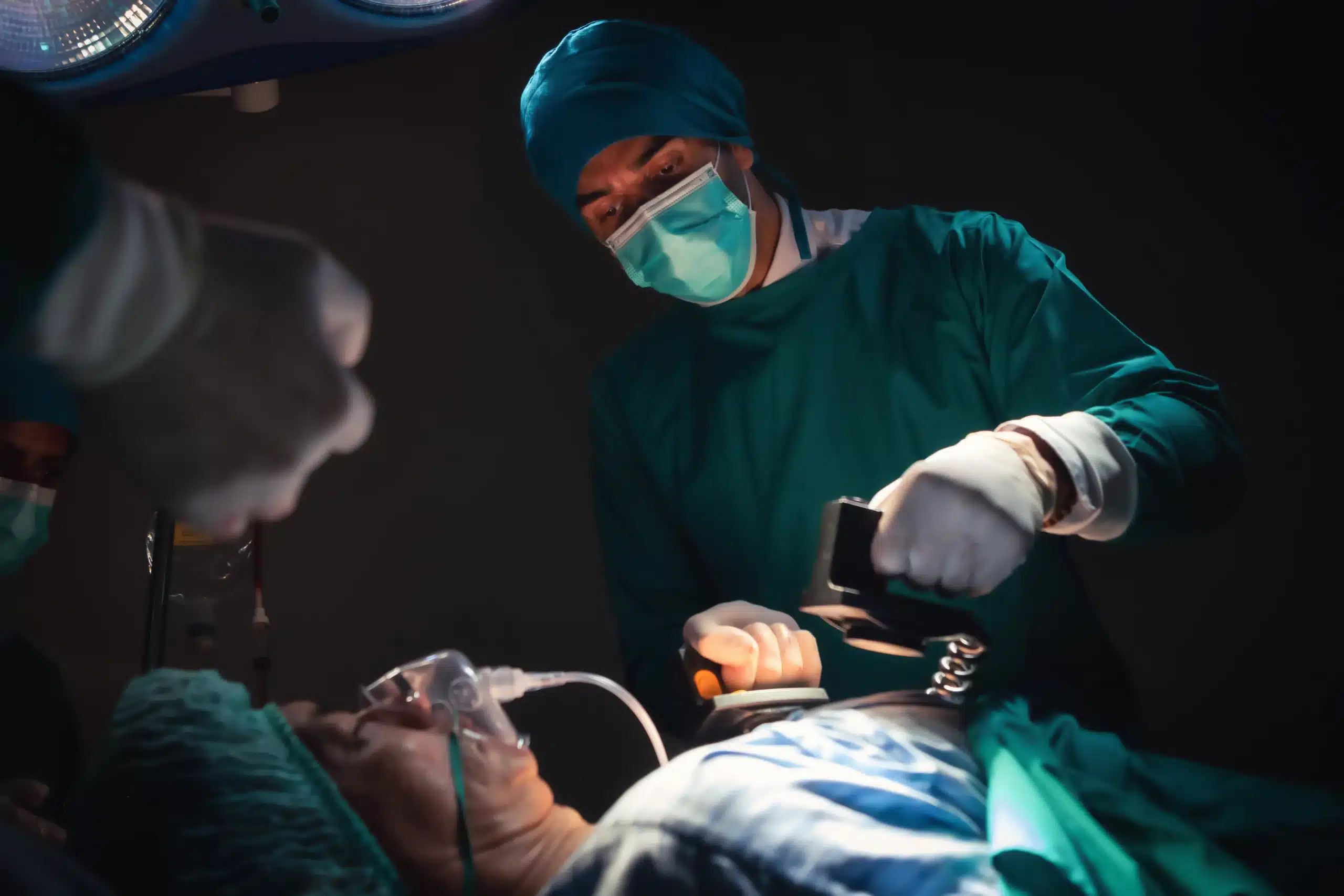Learning CPR can be one of the most empowering decisions you ever make. It equips you to respond effectively in emergencies, potentially saving a life. This guide provides a complete overview of CPR training, from understanding the basics to finding the right course for you. We’ll explore different CPR course types, help you locate CPR courses near me, and explain what a typical class entails. We’ll also cover costs, certification, and the importance of keeping your skills fresh. Plus, we’ll discuss the numerous benefits of CPR training and highlight some leading CPR training providers.
Key Takeaways
- CPR training empowers you to save lives: Whether you’re a healthcare professional, a parent, or simply someone who wants to be prepared, CPR certification equips you with the skills to respond effectively in emergencies. Find a course and learn how to make a difference.
- Select a reputable CPR training provider: Look for instructors certified by organizations like the American Heart Association or the American Red Cross. Consider factors like experience, student reviews, and course content when making your decision.
- CPR skills benefit everyone: From personal preparedness to career advancement and community impact, CPR training offers numerous advantages. Maintain your skills through regular practice and refresher courses to stay prepared and confident in your abilities.
What is CPR? And Why is it Important?
CPR, which stands for Cardiopulmonary Resuscitation, is a lifesaving emergency procedure used when someone’s breathing or heartbeat has stopped. This can happen due to a heart attack, near drowning, or other life-threatening situations. CPR involves chest compressions and rescue breaths that help maintain blood flow and oxygen to vital organs until professional medical help arrives. It can literally mean the difference between life and death.
Learning CPR is important for everyone, not just healthcare professionals. It empowers you to respond effectively during emergencies and potentially save a life. CPR provides immediate support in critical situations, bridging the gap until paramedics arrive. This quick action can significantly increase the chances of survival and improve patient outcomes after a cardiac event. CPR training also helps people manage the stress of these high-pressure situations, allowing them to perform CPR efficiently and confidently. Whether you’re a medical student, a parent, a teacher, or simply someone who wants to be prepared, understanding CPR is a valuable skill. It’s about being equipped to make a real difference. Check out our Northern California CPR directory to find resources and training options near you. We also offer a low price guarantee on our courses, making it even more accessible to learn this essential skill.
CPR Course Types
CPR courses cater to different needs and experience levels. Whether you’re a concerned parent, a healthcare provider, or need CPR training for your workplace, there’s a course designed for you. Let’s explore the main types of CPR courses:
CPR for Everyone
CPR classes are designed for anyone who wants to learn how to respond to emergencies. These courses empower you to provide immediate assistance to someone experiencing cardiac arrest or other life-threatening situations. Community-based CPR training often focuses on making these lifesaving skills accessible to all. The American Red Cross offers CPR classes and certification, with an emphasis on convenient scheduling and locations. These courses typically cover the basics of CPR, giving you the confidence to act quickly and effectively. Safety Training Seminars also offers a comprehensive CPR course designed for the general public.
CPR for Healthcare Professionals
Healthcare professionals require more advanced CPR training to handle the complex medical situations they encounter daily. CPR training is crucial for managing high-stress situations and providing specialized care. These courses cover a broader range of topics, including airway management, using AEDs (automated external defibrillators), and caring for infants and children. Certification in CPR is essential for most healthcare employees who interact with patients. For those in the healthcare field, Safety Training Seminars provides American Heart Association courses like BLS, ACLS, and PALS. You can learn more about who needs CPR training in healthcare. These certifications equip healthcare providers with the skills to respond effectively to cardiac emergencies.
Specialized CPR for Work and School
Many workplaces and schools require specific CPR training to meet OSHA requirements or ensure the safety of their staff and students. These specialized CPR courses may include additional training for responding to emergencies in specific environments, such as construction sites or classrooms. They can also be tailored to the specific needs of different communities. The American Red Cross offers a variety of CPR classes for different sectors, including schools and workplaces. For businesses and schools in Northern California, Safety Training Seminars offers convenient and affordable options, including our low price guarantee. You can find more information in our Northern California CPR directory.
Find CPR Courses Near You
Ready to learn CPR? Finding the right course is easier than you think. Whether you prefer online convenience or in-person instruction, several options are available.
Search Online
Online CPR certifications are a great option for flexible learning. Just make sure the program is accredited by a reputable organization like the American Heart Association (AHA) or the American Red Cross (ARC). Our RQI classes offer a blended learning approach, combining online coursework with in-person skills sessions. This allows you to learn the material at your own pace, then demonstrate your skills to a certified instructor.
Local Training Centers
Many training centers offer in-person CPR classes, providing hands-on practice and direct feedback from instructors. Safety Training Seminars offers CPR courses throughout Northern California, including San Francisco, San Jose, Oakland, Sacramento, Berkeley, and Concord. Check our Northern California CPR directory to find a convenient location.
Community Organizations
Local community centers, hospitals, and fire departments often host CPR training. These organizations frequently offer affordable (or even free) courses, making CPR accessible to everyone. The American Red Cross also provides CPR classes and certification, often with flexible scheduling and various locations. Contact your local community organizations or browse their websites for upcoming training. You can also check with workplaces, schools, and community groups, as they may offer CPR training for members or employees.
What Happens in a CPR Course?
Wondering what to expect in a CPR class? CPR courses are designed to equip you with the skills and confidence to respond effectively in emergencies. Here’s a glimpse into a typical class:
Course Content and Structure
CPR courses cover essential life-saving techniques, including CPR for adults, children, and infants, how to use an Automated External Defibrillator (AED), and Basic Life Support (BLS). You’ll learn how to recognize the signs of a cardiac arrest, when to call 911, and how to perform chest compressions and rescue breaths. Many courses also incorporate training on choking relief and other first-aid basics. The curriculum is presented in a clear, easy-to-understand format, often combining lectures, videos, and demonstrations. For a good example of course content, check out the American Red Cross course offerings.
Hands-on Practice
Hands-on practice is a crucial part of any CPR course. You’ll practice your skills on CPR training mannequins, allowing you to get comfortable with the techniques and build muscle memory. This practical experience is essential for developing the confidence to perform CPR effectively in a real-life emergency. This hands-on training helps dispel common myths surrounding CPR and builds real competence. You’ll learn exactly where and how hard to press to deliver effective chest compressions, giving you the confidence to act quickly and decisively when every second counts. For more information on the importance of hands-on training, take a look at the resources available from Emergency First Response.
Assessment and Certification
At the end of the course, you’ll be assessed on your knowledge and practical skills. Successful completion earns you a CPR certification, typically valid for two years. Many organizations provide same-day certification cards, so you can leave the class ready to put your new skills to use. Check with your chosen training provider for their specific certification process. Maintaining your certification demonstrates your commitment to providing high-quality care and ensures you’re always prepared to help in a crisis. You can easily find renewal courses when your certification is close to expiring. CPR Certification Dallas is a good example of a provider offering various certification options.
CPR Course Costs & Duration
Knowing the price and time commitment for CPR training helps you plan and budget accordingly. While costs can vary, understanding the factors involved makes it easier to find a course that fits your needs.
Typical Course Prices
CPR certification prices typically range from $20 to $80, depending on the course type and location. Combined CPR and First Aid certification often costs slightly more, usually between $40 and $100. At Safety Training Seminars, our CPR certification is $59.95 (currently discounted), and CPR plus First Aid certification is $79.95 (currently discounted). These prices include all training, materials, testing, and certification cards. We also offer a low price guarantee, so you can be confident you’re getting the best value. For those seeking American Heart Association certifications, we provide various courses, including BLS, ACLS, and PALS.
Factors Affecting Cost
Several factors influence the cost of CPR training. The type of course, such as basic CPR or BLS for healthcare providers, plays a significant role. Location matters too, as prices can differ between training centers and regions. For example, courses in major metropolitan areas might be slightly more expensive than those in smaller towns. Also, whether the course includes additional certifications, like First Aid or AED training, can impact the overall cost. Check our CPR directory for a comprehensive list of providers in Northern California.
Course Length and Certification Validity
Most CPR courses take between 2.5 and 4 hours to complete, depending on the content covered. A combined CPR and First Aid course usually takes a full day. It’s important to factor in travel time and any breaks during the course. CPR certification is typically valid for two years. Renewal is often available through shorter refresher courses, especially for those whose certification is nearing its expiration date. Our convenient RQI program offers a fast and efficient way to renew your American Heart Association certification. Contact us to learn more about our courses and schedules.
Choose a Great CPR Trainer
Finding the right CPR instructor can make all the difference in your learning experience. A great instructor can build your confidence and equip you with the skills to respond effectively in an emergency. Here’s what to look for:
Accreditation and Credentials
First, check the instructor’s credentials. Are they certified by a nationally recognized organization like the American Heart Association (AHA)? Legitimate CPR instructors complete a training course and meet specific requirements, including demonstrating proficiency in CPR. The AHA Instructor process also involves key steps to ensure instructors are prepared to teach these life-saving skills. Choosing a certified instructor ensures you’re learning the most up-to-date and effective techniques. Safety Training Seminars offers a variety of AHA-certified courses, including BLS, ACLS, and PALS.
Instructor Qualifications
Beyond basic certification, look for an instructor with a strong background and experience. Do they actively teach and stay current with the latest guidelines? Maintaining instructor status requires ongoing engagement and a commitment to keeping skills sharp, as highlighted in this ACLS Instructor Certification guide. An experienced instructor will be better equipped to answer your questions and provide relevant examples. Effective instructors also create a positive and supportive learning environment. This can significantly impact your comfort level and ability to learn. They should be skilled at demonstrating techniques clearly and assessing student competency, as explained in this guide on becoming a CPR instructor.
Student Reviews
Finally, don’t underestimate student feedback. Reading reviews can offer valuable insights into an instructor’s teaching style, communication skills, and overall effectiveness. Look for comments about the instructor’s ability to create a comfortable and inclusive learning environment. Inclusive CPR programs empower diverse communities to respond effectively in emergencies. Community involvement is also key, ensuring that CPR training reaches a broader audience, as discussed in this article on community CPR training. Consistently positive reviews and a strong community presence signal that an instructor is dedicated to providing high-quality training.
Benefits of CPR Training
Learning CPR offers significant advantages, from personal preparedness to career advancement and community well-being. It’s a skill that empowers you to make a real difference.
Be Prepared
CPR training equips you to handle emergencies effectively. It provides the knowledge and skills to respond confidently if someone experiences sudden cardiac arrest. This preparedness can be invaluable in any setting, whether at home, work, or in your community. As healthcare professionals know, staying calm under pressure is crucial, and CPR training builds that essential composure. Knowing how to perform CPR can give you the confidence to act quickly and potentially save a life.
Professional Growth
For many healthcare roles, CPR certification is a requirement. It demonstrates your commitment to patient safety and enhances your professional qualifications. Whether you’re a medical student, nurse, or in another healthcare field, CPR training is a valuable asset. It’s often considered vital for any role involving patient contact, increasing your job opportunities and demonstrating your dedication to providing high-quality care. CPR training can be a significant step in advancing your healthcare career.
Community Impact
CPR training has a ripple effect, extending beyond individual preparedness to strengthen the entire community. When more people are trained, the chances of someone nearby knowing CPR during an emergency increase dramatically. Community CPR programs create a network of lifesavers, ensuring that help is more likely to be available quickly. Getting involved in these community initiatives can empower those around you to act confidently in emergencies, fostering a safer environment for everyone. By learning CPR, you contribute to a more resilient and prepared community.
Register for a CPR Course
Ready to learn CPR? Great! Registering for a course is usually straightforward. This section walks you through the steps.
Enrollment Steps
Finding a CPR class is easier than ever. Start by visiting the Safety Training Seminars website to see our course schedule and locations throughout Northern California, including San Francisco, San Jose, Oakland, Sacramento, Berkeley, and Concord. We offer various American Heart Association (AHA) courses, like BLS, ACLS, PALS, CPR, and First Aid. Our online registration system lets you quickly find a class that fits your schedule. For groups, we also offer convenient on-site training—contact us to learn more.
Materials and Preparation
We make preparing for your CPR class easy. All required materials are included in the course fee. Once you register, you’ll receive information about the class location and any specific items you might want to bring, like comfortable clothing. You’ll also get access to our online student portal with videos and interactive exercises to familiarize yourself with the techniques. After your class, you’ll continue to have access to these resources and additional refresher materials to help you keep your skills sharp. Our BLS course is a great example of the comprehensive training we offer.
Payment and Discounts
Safety Training Seminars is committed to providing affordable, high-quality training. Check our Low Price Guarantee. We believe everyone should have access to these lifesaving skills. We offer various payment options, and you can typically find information about current discounts on our website. We encourage you to explore our streamlined RQI classes for a fast and efficient certification process. For specific pricing details, visit our website or contact us directly. We’re happy to answer any questions. You can also explore our Northern California CPR directory for more information on CPR training options in your area.
Keep Your CPR Skills Sharp
Learning CPR is a great first step, but staying sharp on your skills is key. Like any skill, CPR requires regular practice and refreshers to maintain proficiency. Here’s how to keep your skills up-to-date:
Practice Regularly
Consistent practice is essential for retaining CPR skills. Think of it like learning an instrument or a new language—the more you practice, the better you become. Studies show that students who practice with mannequins offering immediate feedback are more engaged and perform better. Even practicing on your own can significantly improve your muscle memory and reaction time in a real emergency. Consider setting aside a few minutes each month to review the steps and practice compressions and breaths.
Refresher Courses
CPR certifications typically last for two years. Recertification is often available through an abbreviated training session, especially if your current certification is close to expiring. Refresher courses are also a great way to brush up on your skills and stay current with any updates to CPR guidelines. Check with your local training centers or organizations like the American Red Cross and American Heart Association for available refresher and recertification options. Staying certified ensures you’re always prepared to respond effectively. Contact us to learn more about our CPR courses and refresher options.
Online Resources
Online resources can be valuable tools for maintaining your CPR knowledge between courses. Many reputable organizations, including the American Red Cross, offer online materials and tutorials. However, it’s important to ensure that any online CPR certifications you pursue are issued by accredited organizations like the American Heart Association (AHA) or the American Red Cross. These organizations often have scientific advisory councils that ensure the accuracy and relevance of their training materials. Use online resources to supplement your in-person training and stay informed about the latest CPR practices. For more information on our affordable CPR training options, check out our low price guarantee. We also offer convenient and efficient RQI classes for healthcare professionals seeking a streamlined certification process.
Top CPR Training Providers
Finding the right CPR training provider is crucial for a positive and effective learning experience. Here are some reputable organizations and resources to consider:
Safety Training Seminars
Safety Training Seminars offers comprehensive CPR and first-aid training throughout Northern California. With a focus on affordability and convenience, they provide a variety of American Heart Association courses, including BLS, ACLS, PALS, CPR, and First Aid. Their innovative RQI program offers a fast and efficient certification process. Explore their course schedule and check out their low price guarantee. They also offer a Northern California CPR directory to help you find a class near you. For any questions, contact them directly.
American Heart Association (AHA)
The AHA is a leading authority on CPR and emergency cardiovascular care. They set the standards for CPR training and offer various courses for healthcare providers and the general public. Learn how to become an AHA instructor through their Training Centers. The AHA’s focus on high-quality training and evidence-based practices ensures you receive excellent instruction.
American Red Cross
The American Red Cross is another well-known provider of CPR and first aid training. They offer classes across the country, often with flexible scheduling and various locations. Find a Red Cross CPR class and learn essential lifesaving skills from their trained experts.
National Safety Council
The National Safety Council is a trusted source for safety training and resources. They offer CPR and first aid courses designed to empower individuals to respond effectively in emergencies. Their resources explain the importance of CPR training in various settings.
Local Hospitals and Fire Departments
Many local hospitals and fire departments offer CPR training to their communities. These classes are often affordable and accessible, making them a great option for anyone seeking certification. Check with your local community organizations to find CPR training opportunities. These classes are a great way to learn valuable skills and get involved in your community.
Related Articles
- The Lifesaving Importance of CPR in Healthcare
- CPR Training in Northern California: Your Complete Guide
- CPR Training in Sacramento: A Ultimate Guide
- CPR Courses in San Jose: Find the Right Class for You
- Find CPR Certification Near Me: A Practical Guide
Frequently Asked Questions
What are the different types of CPR courses available? CPR courses range from basic classes for the general public to advanced courses for healthcare professionals. There are also specialized CPR courses designed for specific workplaces or schools. Basic CPR courses teach essential lifesaving skills for adults, children, and infants, while advanced courses like BLS, ACLS, and PALS cover more complex medical situations and procedures.
How do I find a CPR course near me? You can find CPR courses through various avenues. Online searches can help you locate certified instructors or training centers in your area. Local community centers, hospitals, and fire departments often host CPR training sessions. You can also check with workplaces, schools, and community groups, as they may offer CPR training for their members or employees. Safety Training Seminars offers a Northern California CPR directory to help you find local resources.
What can I expect during a CPR class? A typical CPR class combines instruction, demonstrations, and hands-on practice. You’ll learn how to recognize the signs of a cardiac arrest, how to perform CPR on adults, children, and infants, and how to use an AED. Most courses also include training on choking relief and other first-aid basics. You’ll practice your skills on mannequins and receive feedback from instructors. Upon successful completion, you’ll receive a CPR certification, usually valid for two years.
How much does a CPR course cost, and how long does it take? CPR course costs vary depending on the course type and location, generally ranging from $20 to $100. Basic CPR courses tend to be less expensive than more advanced certifications like BLS or combined CPR/First Aid courses. Most CPR courses last between 2.5 and 4 hours, while combined CPR and First Aid courses may take a full day.
How can I maintain my CPR skills after completing a course? Regular practice is key to maintaining your CPR skills. Consider setting aside time each month to review the steps and practice compressions and breaths. Refresher courses are also a great way to stay up-to-date and renew your certification before it expires. Many organizations offer online resources and tutorials to help you keep your skills sharp.


